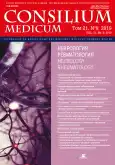AUTONOMIC DYSREFLEXIA IN TETRAPLEGIA AFTER SPINAL CORD INJURY: ORIGINAL ARTICLE
- Authors: Bushkov F.A.1, Salyukov R.V.1
-
Affiliations:
- Rehabilitation center “Preodolenie”
- Issue: Vol 21, No 9 (2019)
- Pages: 126-130
- Section: Articles
- URL: https://journals.rcsi.science/2075-1753/article/view/95325
- DOI: https://doi.org/10.26442/20751753.2019.9.190456
- ID: 95325
Cite item
Full Text
Abstract
Full Text
##article.viewOnOriginalSite##About the authors
Fedor A. Bushkov
Rehabilitation center “Preodolenie”
Email: bushkovfedor@mail.ru
канд. мед. наук, врач-невролог, АО «Реабилитационный центра “Преодоление"» Москва, Россия
Roman V. Salyukov
Rehabilitation center “Preodolenie”канд. мед. наук, врач-уролог, АО «Реабилитационный центра “Преодоление"» Москва, Россия
References
- Krassioukov AV, Karlsson AK, Wecht JM et al. Joint Committee of American Spinal Injury Association and International Spinal Cord Society. Assessment of autonomic dysfunction following spinal cord injury: rationale for additions to International Standards for Neurological Assessment. J Rehabil Res Dev 2007; 44 (1): 103-12.
- Braddomand RL, Rocco JF. Autonomic dysreflexia. A survey of current treatment. Am J Physical Med Rehabil 1991; 70 (5): 234-41.
- Curt A, Nitsche B, Rodic B et al. Assessment of autonomic dysreflexia in patients with spinal cord injury. J Neurol Neurosurg Psychiatry 1997; 62: 473-7.
- Popok DW, West CR, Hubli M et al. Characterizing the Severity of Autonomic Cardiovascular Dysfunction after Spinal Cord Injury Using a Novel 24-Hour Ambulatory Blood Pressure Analysis Software. J Neurotrauma 2017; 34 (3): 559-66. doi: 10.1089/neu.2016.4573
- Teasell RW, Malcolm OA, Krassioukov A, Delaney GA. Cardiovascular consequences of loss of supraspinal control of the sympathetic nervous system after spinal cord injury. Arch Phys Med Re-habil 2000; 81: 506-16.
- Claydon VE, Elliott SL, Sheel AW, Krassioukov A. Cardiovascular responses to vibrostimulation for sperm retrieval in men with spinal cord injury. J Spinal Cord Med 2006; 29 (3): 207-16.
- Lee BY, Karmakar MG, Herz BL, Sturgill RA. Autonomic dysreflexia revisited. J Spinal Cord Med 1995; 18: 75-87.
- Stjenberg L, Blumberg H, Wallin BG. Sympathetic activity in man after spinal cord injury: outflow to muscle below the lession. Brain 1986; 109: 695-715.
- Gao SA, Ambring A, Lambert G, Karlson AK. Autonomic control of the heart and renal vascular bed during autonomic dysreflexia in high spinal cord injury. Clin Autom Res 2002; 12:457-64.
- Yeoh M, McLachlan EM, Brock JA. Tail arteries from chronically spinalized rats have potentiated responses to nerve stimulation in vitro. J Physiol 2004; 556: 545-55.
- Karlsson AK, Friberg P, Lonnroth P et al. Regional sympathetic function in high spinal cord injury during mental stress and autonomic dysreflexia. Brain 1998; 121 (9): 1711-9.
- Lee ES, Joo MC. Prevalence of Autonomic Dysreflexia in Patients with Spinal Cord Injury above T6. Biomed Res Int 2017; 2017: 2027594. doi: 10.1155/2017/2027594
- Karlsson AK. Autonomic dysreflexia. Spinal Cord 1999; 37 (6): 383-91.
- Giannantoni A, Di Stasi SM, Scivoletto G et al. Autonomic dysreflexia during urodynamics. Spinal Cord 1998; 36 (11): 756-60.
- Kirshblum SC, House JG, O’Connor KC. Silent autonomic dysreflexia during a routine bowel program in person with traumatic spinal cord injury: preliminary study. Arch Phys Med Rehabil 2002; 83: 1774-6.
- Гапеева Л.С., Еселевич Э.И. О спинальных вегетативных пароксизмах. Клиническая медицина. 1973; 9: 80-4. [Gapeeva L.S., Eselevich E.I. O spinal'nykh vegetativnykh paroksizmakh. Klinicheskaya meditsi-na. 1973; 9: 80-4 (in Russian).]
- Claydon VE, Krassioukov AV. Clinical correlates of frequency analyses of cardiovascular control after spinal cord injury. Am J Physiol Heart Circ Physiol 2008; 294 (2): 668-78.
- Elliott S, Krassioukov A. Malignant autonomic dysreflexia in spinal cord injured men. Spinal Cord 2006; 44: 386-92.
- Yarcony GM, Katz RT, Wu Y Seizures secondary to anatonomic dysreflexia. Arch Phys Med Rehabil 1986;67:834-5.
- Pine ZM, Miller SD, Alonso JA. Atrial fibrillation associated with autonomic dysreflexia. Am J Phys Med Rehabil 1991; 70 (5): 271-3.
- Eltorai I, Kim R, Vulpe M et al. Fatal cerebral hemorrhage due to autonomic dysreflexia in a tetrap-legic patients: case report and review. Paraplegia 1992; 30: 355-60.
- Marino RJ, Barros T, Biering-Sorensen F et al. ASIA Neurological Standards Committee 2002. International standards for neurological classification of spinal cord injury. J Spinal Cord Med 2003; 26 (Suppl. 1): S50-6.
- Hubli M, Gee CM, Krassioukov AV. Refined assessment of blood pressure instability after spinal cord injury. Am J Hypertens 2015; 28 (2): 173-81. doi: 10.1093/ajh/hpu122
- Hubli M, Krassioukov AV. Ambulatory blood pressure monitoring in spinal cord injury: clinical practicability. J Neurotrauma 2014; 31 (9): 789-97. doi: 10.1089/neu.2013.3148
- Михайлов В.М. Вариабельность ритма сердца: опыт практического применения метода. Изд. 2-е, перераб. и доп. Иваново: Иван. Гос. Мед. Академия, 2002. [Mikhailov V.M. Heart rate variability: experience of practical application of the method. Izd. vtoroe, pererab. i dop. Ivanovo: Ivan. Gos. Med. Akademiya, 2002. (in Russian).]
- Nitsche B, Perschak H, Curt A, Dietz V. Loss of circadian blood pressure variability in complete tetraplegia. J Hum Hypertens 1996; 10 (5): 311-7.
- Krassioukov A, Biering-Sorensen F, Donovan W et al; Autonomic Standards Committee of the American Spinal Injury Association/International Spinal Cord Society. International standards to document remaining autonomic function after spinal cord injury. J Spinal Cord Med 2012; 35 (4): 201-10. doi: 10.1179/1079026812Z.00000000053
- Бутуханов В.В. Особенности регуляции сердечно-сосудистой и дыхательной систем у больных с травмой спинного мозга. Ортопедия, травматология и протезирование. Медицина. 1983; 7: 21-4. [Butukhanov V.V. Osobennosti reguliatsii serdechno-sosudistoi i dykhatel'noi sistem u bol'nykh s travmoi spinnogo mozga. Ortopediia, travmatologiia i protezirovanie. Meditsina. 1983; 7: 21-4 (in Russian).]
- Grasso R, Schena F, Gulli G, Cevese A. Does low-frequency variability of heart period reflect a specific parasympathetic mechanism? J Auton Nerv Syst 1997; 63: 30-8.
Supplementary files






